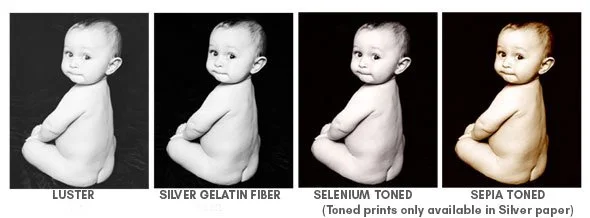Silver Gelatin Prints - Museum quality with Timeless antiquity
GELATIN SILVER PRINTS
We offer a special type of print, we call the Silver print, also called the Gelatin Silver Fiber print or the Silver Gelatin Fiber print. Why are these so special? Read on to learn more.Our current Silver Gelatin prints are created from the marriage of modern digital technology and traditional exposure/chemical printing to create a true black and white print. Combining the best of both worlds, you are left with an unbeatable product. So, why should you choose silver gelatin prints for your pregnancy art photography and what are they?? I interviewed our printer who was formerly with Ilford, the paper and film company I have used for more than 30 years. Eric is now an expert on black and white Silver Gelatin Printing using digital files.He is the best and his team has been trusted to print not just my work, but really amazing famous photographers.
1)Why do you love Silver Gelatin Fiber Prints?
As a purist, I believe black and white print should be produced using B&W materials, not color papers, dyes and pigments. I want my prints to be neutral in tone, and this is the only true way to achieve that.
2) Tell us about Silver Gelatin Fiber Prints?
Silver gelatin prints are the most common method used to produce B&W prints since the late 1890’s. A negative was exposed by light in an enlarger onto a coated paper hat has a silver emulsion. The silver reacts to the light to produce the photographic image from the film. Today, the digital file (from film scans or digital camera) are exposed with light using an RGB laser printer (think MRI machine) onto the same light sensitive photographic paper. The paper is processed in traditional B&W chemicals to produce the only truly neutral toned black and white print, which is a stable silver gelatin print.
3) What makes them better than other prints sold by portrait photographers?
Silver gelatin (same as "gelatin silver”) prints are the gold standard when it comes to Black and White prints. Most labs print clients’ B&W digital files onto Kodak or Fuji color papers, and try to make the prints “appear” B&W. These prints often have a magenta (purple) or cyan (blue) cast to them because the process is not a true B&W process. These color prints are very unstable when it comes to longevity and can shift in color in as little as 8-10 years. Inkjet prints are better than the color prints, however there are myriad paper and ink combinations and you need to be sure they are using the most archival materials. These inkjet prints, which use color inks, can also show some color cast to your black & white images.
4) Why are they so expensive?
Silver Gelatin prints are the only artisanal print and require expertise and much time to produce. Once the image is projected onto the paper, the prints come out of the chemistry wet and require air drying on large screens. The fiber paper tends to curl as it dries, and needs to be flattened in a large press by hand. Each print is carefully examined to make sure it is perfect, and if it is, then it is trimmed by hand. Each print can take days to make if there are mistakes or the tonal range isn’t correct. The beauty, quality, and longevity makes these fine art prints worth the investment.
5) Why do you recommend Silver Gelatin Prints for family photographs and fine art pregnancy photography?
These prints are archival and beautiful - think heirloom quality. We want these precious memories to last for generations. Most of the current lab prints are not designed to do this.
6) Anything you want to add?
When I started working for Ilford, back in 1995, I joined them because of their dedication to the B&W photography and materials. As digital evolved, people turned their attention to color images. After all, our new digital cameras were producing these color images and everything was geared in that direction. Like everyone else, I got caught up in the digital evolution. As a result, printing also suffered in the early 2000’s. In 2006, Ilford brought out this B&W emulsion, that could be exposed in these laser enlargers, (Lambda’s and Lightjets) and processed in traditional B&W chemicals. By 2008, they had perfected the emulsion on both Resin Coated (RC) and Fiber papers. I decided it was time to go out on my own. I have a great team of dedicated employees, who are all passionate about photography. As a team, we have built our reputation and work with photographers all over the country, producing single images and entire exhibitions. We enjoy working with photographers like you who understand the importance of and value quality printing of black and white images.

